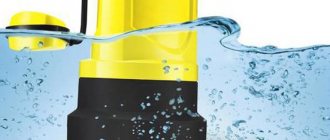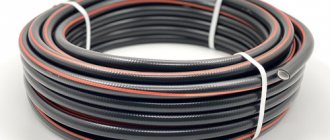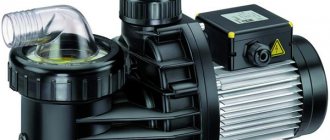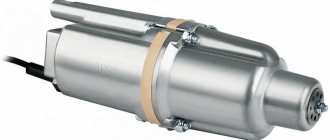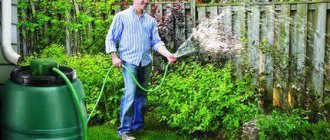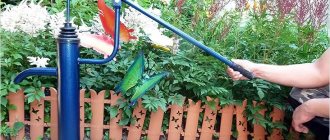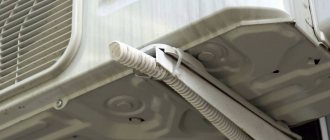If you are looking for a pump for a basement or cellar, do not rush: first figure out whether it is possible to pump water out of there or is it better to wait until it drains naturally. This is a very important factor affecting the groundwater balance, and intervention can be critical to the integrity of the walls of the structure.
Consequence of violation of the technology for arranging external waterproofing or its absence Source aqua-rmnt.com
Types of pumps
Pumps for drinking water and dirty water
Pumps for industrial water
Divided into two types:
- fecal type;
- drainage type.
However, drainage pumps are capable of pumping liquids with large solid elements. Therefore, in order not to damage the unit, a filter with a fine mesh is attached to the pipe. This will prevent large waste from getting inside the unit. This type of pump is universal and can be used not only for basements and cellars. It is used when cleaning dirty swimming pools, artificially created reservoirs, and wells.
This is not the case with a fecal pump. It is not intended for pumping liquids containing solids. Some models of such devices may have a cutting mechanism for shredding large debris.
Submersible pump “Baby”
A representative of this type of pumping equipment is the “Malysh” submersible pump.
The pump is immersed in water, and it should not lie on the bottom, since it takes in liquid with the lower part, and at the bottom there are silty deposits that can clog it. The device does not require special cooling of the electric motor elements because the waste materials themselves have a low temperature. The device may be equipped with a circuit breaker. So, when the liquid reaches a specific point, using a float, the device is disconnected from the network. If the maximum level of wastewater is exceeded, the unit starts working again.
The Baby's body is equipped with reliable waterproofing. If the seal of the housing is broken, water can enter the engine and damage it. Therefore, you need to periodically remove the device from the water and check the integrity of the housing.
Submersible and external pumps
Principle of operation
These types, depending on the methods of work, are divided into submersible and external. The operation of a submersible pump involves its complete immersion in water.
These pumps must meet the following requirements:
- resistance to chemicals;
- to corrosive formations;
External pumps are only partially lowered into the liquid; the main part of the device is on the surface of the water. Basically, these devices are mobile, but less powerful than the submersible type, which helps save energy.
Grundfos Unilift KP 150-A1
Photo: https://beru.ru/
Submersible drainage pump for handling slightly contaminated liquids. The size of permissible solid inclusions is 10 mm. Larger particles are retained by a mesh at the base of the drainage basin. The case is made of stainless steel. The asynchronous motor is cooled by passing fluid. Thanks to this, it can work indefinitely without overheating. 1¼" outlet. The float switch turns the unit on and off when it reaches a certain level. The motor is protected from overheating, turns off in case of overload and turns on again when it cools down to normal temperature.
Drainage pump Unilift KP 150-A1 (300 W)
Advantages:
- stainless steel housing
- immersion depth – 10 meters
- high permissible temperature – 50°
- compact dimensions
Flaws:
- high price
Features of external pumps
These devices are designed for periodic pumping of water.
Their prolonged use puts a lot of stress on the mechanism, which leads to breakdown. Liquid intake occurs through flexible hoses. In this way, it is possible to pump out liquids up to eleven meters deep. Moreover, the presence of large particles up to ten millimeters in water is acceptable.
Centrifugal type unit design
The unit has a pump chamber and a motor compartment. The rotor (shaft) connects the working compartment and the engine. The shaft contains wheels with blades designed to pump liquid and maintain high line pressure. This pump is easy to install. The body is mainly made of polymer or stainless steel.
Manufacturers of these pumps are such global brands as Gardena, Pedrollo, Karcher, Dab. There are also domestic manufacturers - Gileks and Sprut. The most popular brand of devices for pumping out dirty water is Pedrollo Pkm60. This model is capable of maintaining pressure up to forty meters, as well as pumping up to two thousand liters of water in 1 hour. Equipped with a cast iron body.
We should also highlight the OPTIMA JET 80S-PL pump, which has established itself as the best among the owners of country houses. The case is made of steel and has a power of up to eight hundred watts. Maintains pressure at a distance of up to thirty-three meters. Capable of pumping water up to 3 cubic meters. m/hour.
Centrifugal units
The housing of centrifugal pumps can be monolithic or cantilever.
The top of the device performs a protective function, and the work area is located at the bottom. The chamber contains impellers with an impeller in a circle. There is a filter with a mesh under the wheels. There is a stand on the bottom of the device. They have a throughput capacity of no more than two to two and a half centimeters. The following brands of submersible pumps are Aquatica, Grudfos, Gilex, Metabo, Sturm.
The most common is the Aosta AB SMP 400SS DO pump, which has a power of up to four hundred watts. The unit has an auxiliary discharge connection. Automated operation occurs through a float switch. Can work at a depth of up to five meters. Withstands water pressure at a distance of up to ten meters. Capable of pumping liquids up to 298 l/min.
You can also highlight the domestic pump Drainage 200/25, produced by the company Gilex.
Vibration units
The liquid is pumped through the oscillating movements of the resonator. Centrifugal devices are represented by dynamic devices, and vibrating devices are volumetric devices.
The working chamber of such devices has a membrane that serves as a closure to the engine compartment. It is fixed on a metal rod. The engine here is replaced by a capacitor, which attracts liquid during the working process.
At the same time, the working chamber expands, and water is drawn in through a vacuum. When the chamber narrows, the liquid is pushed into the pipe and the inlet is closed using an inverse valve. This ensures water supply without jerking. In terms of productivity, this type is inferior to the centrifugal one.
Water pumps of both submersible and surface types are quite expensive. So, for periodic use, it is not always advisable to purchase an expensive electric pump. The best option here would be to purchase a hand pump. This device is made like a pneumatic hand pump. Here the piston represents the working element.
When the handle is lifted upward, the rod and cylinder are tightened. In this case, the chamber is filled with rarefied air and water begins to be absorbed. When the handle is turned down, the pressure increases and the liquid closes the valve in the suction hole and all water under pressure is discharged through the pipe.
Naturally, in terms of functional characteristics, a manual type device cannot compete with electric devices, but in terms of ease of operation it can compete with electric models.
Operating principle
A submersible pump combines both the pump itself and an electric motor in a common sealed housing. Its operating principle is the same for garden and drainage options . The motor rotates the wheel blades and the chamber fills with water.
Under the influence of centrifugal force, the liquid is displaced and enters the drain pipe. The hole for the fence can be either top or bottom. The first will not allow all the water to be poured out, but the drain will not become clogged with large leaves and silt. The second will empty the pool down to a centimeter , but you will need to carefully monitor the cleanliness of the bottom.
Surface electric pumps can be vortex, centrifugal and with an external ejector . The latter are now almost never produced; they have been replaced by submersible ones.
Vortex pools are not applicable for country pools, because they wear out from sand. Only centrifugal ones are suitable for swimming pools.
Centrifugal models have wheels that are driven by a working shaft supported by bearings. The wheels build up pressure, the water rises, then drains through the outlet pipe. All electric pumps have a relay sensor; it switches off when the water supply is stopped .
Recommendations for use
In order for the pump for pumping out dirty water to work without interruptions and frequent breakdowns, it is necessary to follow certain rules for its use. This also includes the conditions that must be created when operating the drainage pump.
- The ambient temperature in which the self-priming pump for dirty water operates should not exceed 40°.
- The density of the liquid for pumping out which self-priming drainage pumps are used should not exceed 1000–1200 kg/m3.
- The amount of solid inclusions in the liquid medium that the drainage pump will pump out should not exceed 10%.
- Industrial hydraulic machines for contaminated water are connected to a three-phase electrical network with a voltage of 380 V, household models - to a single-phase one (with a voltage of 220 V and a frequency of 50 Hz).
Safety rules at work
When working with pumps, safety rules must be followed. First of all, these are the standard requirements when working with electrical installations:
- serviceable wires, insulation, switches;
- presence of a grounding conductor;
- correspondence of the network voltage with the installation parameters.
In addition, special requirements must be taken into account:
- there should be no people in the pool bowl while the pump is operating;
- Do not leave a working device unattended;
- operating conditions must comply with the manufacturer's requirements (temperature, supply voltage, etc.).
How to choose the right model
Among the models of drainage pumps for dirty water, how to choose the best option? When purchasing a pump for pumping water from a basement or cellar, you should first decide on the list of tasks for which such equipment will be used. We list the parameters by which drainage, as well as well or borehole electric pumps are selected.
Characteristics of the pumped liquid
This refers to its type, degree of contamination, as well as the maximum particle size of solid inclusions contained in its composition. In particular, the diameters of the inlet and pressure pipes of the selected pump, as well as the volume of its internal working chamber, depend on this characteristic.
The stainless steel mesh filter is reliable and durable
Performance
This parameter characterizes the volume of liquid that the pump is capable of pumping per unit of time. You should focus on the degree of intensity with which you plan to use the pumping equipment, as well as the amount of dirty water that it will have to pump out.
Created pressure
This parameter determines the degree of contamination of the liquid that a pump of a certain model can pump out from a cellar or basement, and the distance over which the pumped liquid will be transported along a horizontal section of the pipeline or hose. The depth from which such equipment can pump out a liquid medium also depends on the pressure value created by the electric pump. If you are thinking about how to pump water from a well or borehole and ensure its transportation through an irrigation or water supply system, consider not only the depth of the underground source and the total length of the horizontal section of the pipeline, but also the height to which the water pumped must be raised above the surface of the earth.
Ease of use will also be an important criterion for choosing a pump. For example, easy adjustment of the pumping level by moving the sensor or quick connection of the pressure hose
Location of the inlet pipe
The inlet pipe can be located at the top or bottom of the pump housing, as well as on its side. In the event that the selected hydraulic machine is planned to be used for pumping liquid media from flooded cellars or basements, preference should be given to models with a lower nozzle location. If, with the help of a drainage pump, water will be pumped out of silted reservoirs, it is better to choose equipment with an upper location of this element.
Availability of additional options
If you are interested in purchasing a really good drainage pump, it is better to opt for models that are equipped with all the necessary automation elements. This includes, in particular, idle and overheat sensors, as well as float-type switches. In this case, you need to know the following fact: while floatless drainage pumps can be selected for pumping water from basements, trenches or cellars, it is not recommended to use them for pumping liquid media from wells, septic tanks or cesspools.
If you do not take into account the prestige of the manufacturer, the cost of drainage pumps is significantly influenced by their performance and the ability to pump liquids with large solid particles
Briefly about the main thing
Drainage pumps, originally created for draining basements, have now significantly expanded their scope of application. They can be found in wells and swimming pools, cleaning pits, basements, and pumping wells.
Submersible models have an advantage over their surface counterparts when lifting water from a well, but they are more difficult to maintain. In a suburban area, drainage specialists are responsible for a lot of work, which is why a competent approach to their selection is so important.
When comparing different versions of devices, pay attention to their main characteristics: power, height of water rise, ability to pump impurities. A suitable model is determined based on the type of work planned; for large volumes of work, pumps with a stainless steel housing and motor shaft are preferred.
Compact pumping stations for domestic use
For the uninterrupted and efficient functioning of autonomous water supply systems for dachas and private houses in automatic mode, compact pumping stations have recently been increasingly used. The use of such stations, which include several technical devices, makes it possible to minimize human participation in controlling the operation of pumping equipment due to automation elements. The compact dimensions of household pumping stations for pumping water, which, despite their small size, are characterized by high performance and are capable of creating good pressure in the pipeline system, allow such equipment to be installed in any convenient place, including in the basement of a residential building.
The household pumping station includes the following technical devices:
- submersible centrifugal pump that pumps water from an underground source;
- a filtration unit in which water from an underground source is purified from solid inclusions;
- a circulation pump designed to pump water from the filter unit to the station’s hydraulic accumulator;
- a hydraulic accumulator, the internal chamber of which, filled with water, is equipped with a special membrane (the task of this device is to maintain constant pressure of the liquid medium in the autonomous water supply system, as well as to provide this system with water in those moments when the station pump does not work due to a breakdown or lack of power).
Automatic pumping station for individual water supply systems and small garden plots
The operation of a household pumping station in automatic mode is ensured by a pressure switch, which automatically turns off the pumping equipment if the level of water pressure in the accumulator rises to a critical level, and also turns it on when such pressure drops below the permissible value.
Mini-pumps are actively used not only in everyday life, but also in industry, in particular in food industry enterprises. To pump liquid and viscous media used in technological processes at enterprises in this industry, special food pumps are needed, the structural elements of which are made of materials that are highly resistant to oxidation and do not release harmful substances into the pumped medium.
Surface-type unit for pumping out wastewater
Installation of such pumps is carried out indoors, which are reliably protected from moisture and frost. The best option for placing this equipment is premises located in close proximity to the cesspool.
Such pumps have certain advantages:
- mobility. Such pumps can be used not only for pumping wastewater, but also for other purposes;
- Compared to submersible pumps, these units have lower power. Therefore, using them for domestic purposes, you can save electricity;
- a mechanism for grinding small waste, as well as large, medium-sized fecal matter;
- acceptable cost.
Overview of possible options
A pool in the basement, garden or home should ensure the safety of swimmers. Therefore, the presence of blooming water in the bowl that does not meet the requirements of sanitary and hygienic standards should under no circumstances be allowed. To prevent problems and timely cleaning of the walls of the bowl, water is periodically pumped out of the pool using various pumps.
1. Immersion format – a combination of simple design and impressive functionality
Using submersible pumping equipment for his pool, the developer will be able to pump water through a grate located in his body. Using the equipment is very simple - it is placed on the bottom of the pool and the motor is started, after which the water is pumped and supplied upward. The device is used not only for pools, but also for draining wells, cesspools, basements and cellars.
Among the advantages of the pump, it is worth highlighting its prevalence, light weight, compact dimensions and affordability. The disadvantages also cannot be ignored. They are represented by limited performance.
2. Surface pump – ease of use and high power
If for some reason the developer does not consider the possibility of using submersible equipment, he still has the option of using a surface pump. It has a completely different format. The equipment is placed above the surface of the water surface, and a special flank connected to the body is lowered into a bowl of water. When the equipment motor is started, water begins to be pumped out of the tank.
Where to drain the pool water
The technology for emptying medium and large frame pools largely depends on the drain point. When choosing it, the characteristics of the area and standards for waste water disposal are taken into account.
Into a natural reservoir
If there is a river, lake or ditch near the dacha, the water from the pool can be drained there. This is the most convenient option, allowing you to implement the process in the shortest possible time.
Some limitations should be taken into account:
- It is prohibited to pour excessively dirty water into a natural body of water.
- The liquid to be removed should not contain chlorine or other chemicals.
- Before starting the procedure, you must coordinate your actions with local authorities.
The most convenient way to transport water from the pool to the reservoir is to organize a temporary pipeline, equipping it with a pump. The optimal pipe diameter is considered to be 110-150 mm. It is advisable to lay the route in a straight line, with, if the landscape allows, a slight slope towards the drainage point. If the pool is operated on an ongoing basis, and the distance to the reservoir is small (up to 100 m), the pipeline is laid in a trench. This saves time on its assembly and disassembly.
Frame
To pump water out of an inflatable or frame pool, you can use the included filtration pump. The hose through which purified water flows back into the container is connected not to the pool, but to the outlet hose through a coupling or adapter. However, all the water cannot be drained in this way, since the equipment is installed on the fence at a considerable height from the bottom. For final pumping, you will have to use a special or household drainage pump. Or connect it to the process initially.
You may also be interested in a well pumping station.
Special pool drainers differ from household drainers in their smaller power and dimensions. These are compact models that will collect almost all the water from an inflatable or frame structure. In addition, they are designed to clean the bottom from dirt and can serve as a water vacuum cleaner during the swimming season. The convenient handle allows you to move the device across the entire bottom of the pool.
For inflatables
The most common for summer cottage use are inflatable pools; recently, they have been successfully replaced as leaders by frame varieties. Both are distinguished by their mobility, they can be installed wherever you want, and ease of use. In the middle of the season, if proper measures have not been taken to purify the water, the pool may need to be drained, or this will happen at the end of the swimming season, when it needs to be prepared for wintering. In any case, it is impossible to spit out several cubes with buckets, and the water will not flow by gravity due to the safety valves.
It is possible that you will find the material about pumps for watering a garden from a barrel useful.
Organization of a receiver for draining water
It happens that there is no central sewerage system in a populated area, and the degree of contamination of the water in the pool does not allow it to be drained into a reservoir or used for irrigation. There is only one way out - to organize a special receiver on the backyard territory. In this case, the water has to be drained gradually, since such a structure is not able to accept too large volumes.
Rules for arranging the receiver:
- The receiver should be located below the bottom of the bowl. The simplest option is to dig a hole with a volume of 1 m³, strengthening its walls with brickwork.
- The bottom is also laid out with bricks, but not completely, but with some gaps. This will allow the runoff to soak into the ground. Instead of brick, crushed stone backfill is sometimes used, which creates good conditions for drainage.
- Cover the pit with a strong lid, making a hole in it for the ventilation tube. Having laid the hatch on the hole, pour a layer of earth on top. The drainage entrance can be made in the lid itself, or on the side (if a permanent drainage pipeline is laid on the site).
In general, the design of the receiver is similar to a drainage pit, and is capable of receiving no more than 1 m3 of wastewater at a time.
Down the drain
Disposing of waste water into the central sewer system is considered the most correct option. In this case, there is no threat of environmental pollution or flooding of the site. Therefore, if there is a corresponding pipeline on or near the household territory, a permanent pipeline is laid to it. As a rule, collapsible plastic pipes with a diameter of 110-150 cm are used for this: they must be laid at an angle of 3 degrees per 1 lm towards the drain.
If the sewer inlet is located near the pool, you can do without a pump when draining. To do this, connect a tube to the drainage hole by inserting it into the branch pipe of the permanent line. As a rule, this pipe is installed next to the pool and covered with a special lid.
The speed of emptying the bowl will depend on its volume, the angle of the line and the number of turning sections (if possible, they should be reduced as much as possible). Before starting the process of draining water into the sewer, it is necessary to clarify with the local administration the size of the limit for waste discharged into a common pipe. This will make it possible to correctly regulate the rate of water removal by selecting a pump of the required power.
For watering
If no chemicals are added to the water during the operation of the pool, and swimming occurs without synthetic soaps and shampoos, the drained liquid can be used for watering the garden, vegetable garden and flower beds. Most often this is done in the summer, when preventative water replacement is carried out. Watering the land can be done immediately, or water can be pumped into a reserve tank. This requires a garden hose of the required length and a surface pump.
In cases where the water still contains a small percentage of impurities (detergents or bleach), it can be used for technical purposes. For example, such a liquid can easily be used to wash a car or use it for washing and cleaning premises. If construction work is being carried out at the dacha, then the drained water is used for mixing solutions, paints, and washing tools. In any case, before pouring water into a ditch, it is advisable to come up with a more practical use for it.
Review of models and manufacturers
The selection of equipment begins with an inspection of how much a particular model costs.
But it is important to pay attention to the manufacturer. Here are several options for water pumping/pumping equipment that are deservedly popular:
- A water jet is equipment designed for pumping flows from a well/borehole. The throughput of insoluble inclusions is low, price starts from $80
- Baby - a design ideal for summer cottages. Low performance affects the low price (from $40).
- A brook is a device for supplying water from wells and wells of medium depth. Unpretentiousness to the percentage of contamination, excellent performance, ease of installation and lightness of the device are complemented by low cost (from $30), but the service life is no more than 3-5 years.
- The Gilex model range is equipment intended for domestic use in both water supply and sewerage systems. Excellent practical qualities, work with different depths, unpretentiousness to contamination, a very long service life and good maintainability are clear advantages of the brand. Equipment cost from $200
- Belamos - models are used for supplying clean drinking water and irrigation. They have a built-in control unit, which makes the units easier to use, and can operate in manual, automatic and scheduled modes. There is also a filter to improve the quality of the supplied flow, overload protection, productivity up to 2800 l/hour, supply depth up to 8 meters. Price from 150 $
- Gardena is a brand of highly reliable equipment. Universal devices are able to cope with the supply of liquid without interruptions to high floors, be used for irrigation and at the same time are unpretentious to contamination, as they are equipped with a high-quality filter. Power up to 4000 l/hour, readiness for use immediately after purchase, the presence of 2 outlets for a hose (for irrigation and supply of drinking water), a low noise threshold and a drainage tube for draining liquid add advantages to the device. Price from 120 $
- Aquarius is an ideal pump for wells up to 45 meters deep. The reliability of the unit is confirmed by the execution of parts made of brass and stainless steel, there is a thermal relay, as well as complete immunity to power supply fluctuations (performance will decrease, but the device will not break). Silent operation is also a plus, but it is better to use the unit on clean flows. Price from 120 $
- Vortex – pumps for deep wells (from 60 meters). Chrome parts, a durable body, a pressure of up to 100 meters and a price from $100 are the advantages of the unit. But energy consumption up to 1100 W is a drawback. However, the presence of overheating protection functions, smooth running, high pressure, and high-quality assembly exceed the disadvantages.
All presented models from the Russian manufacturer have unique features - they are adapted to power outages, are resistant to mechanical stress and are easy to install. For users who prefer more expensive units, there are alternative options:
- The Grundfos model range is an offer from German manufacturers. The company produces equipment for supplying and pumping liquids from wells, boreholes, and reservoirs. The devices are equipped with sensors for overheating, overload, protection against dry running and voltage surges. Such functionality significantly extends the life of the devices, but raises the price to $150. However, no matter how much the units cost, they deserve their price - the brand, according to consumers, is considered a leader in its field.
- Unipump is a brand of equipment indicated for use in wells with a high content of insoluble inclusions (up to 100 g/m3). Supply height up to 52 meters, productivity up to 4.8 m3/hour. There is overheating protection, soft start, and automatic operation, but you will have to be careful when using it if the liquid is very hard. Price starts from $110, efficiency and noiselessness are advantages, but a weak network drive is a disadvantage of the equipment.
A preliminary analysis of the needs, the design of the water intake source, determination of the length of the flow supply and the functional features of the water supply will allow not only to choose a good quality device, but also to correctly determine exactly how many pumps will be required for the uninterrupted supply of water to a house, farm or suburban area.
Denzel DPX800
Photo: https://beru.ru/
Drainage pump for draining basements, irrigating gardens, draining swimming pools and drawing from wells or open reservoirs. Can handle dirty water with solid particles no larger than 35 mm. The housing is made of glass-filled plastic, does not corrode, and protects the engine. The model has 2 modes - manual and automatic. For the second option, a float mechanism is provided that responds to changes in level. Overheat protection switches off the engine in case of danger. The wire is long - 10 meters.
Drainage pump Denzel DPХ800 (800 W)
Advantages:
- manual operation possible
- high power
- long cord
- low noise level
Flaws:
- not detected
Installing a waterproof barrier in the basement
There is a solution to the problem of basement flooding in houses on flat areas, which, although it does not eliminate the cause itself, like drainage, allows you to completely do without any temporary devices. We are talking about organizing a waterproof barrier inside the basement - essentially a “trough” over the entire surface of the walls and floor. How this is done will be discussed further.
Generally speaking, there is no need to make such a barrier along the entire height of the basement walls. It is enough to raise its level 100 mm above the highest groundwater level. Of course, you can simply make a barrier to the soil level - water simply cannot rise higher, but the high price of the materials used in this method requires corresponding savings, and this can only be achieved by avoiding overspending. Accordingly, the first thing that needs to be done is to determine the level of the primer and, thereby, determine the upper limit of waterproofing.
Next, you need to decide what exactly needs to be done to create a waterproof barrier. There are two options here:
- If the basement is a reinforced concrete monolith-trough, poured in one go, then it will be enough to treat it from the inside with impregnating waterproofing. This is a special mixture that penetrates into the pores and microcracks of concrete and contains additives that crystallize in water. The crystals formed clog all the pores in the concrete, thereby forming a waterproof barrier - what we need.
- Any other case, including a reinforced concrete monolith poured several times, because even this option cannot be considered a full-fledged monolith, since each new pour over the existing concrete creates a highly permeable boundary between different layers; for water it is, in fact, almost a crack. Penetrating waterproofing, which clogs only microcracks and pores, will be powerless here. What can we say about all sorts of combined options, for example, walls made of concrete blocks or bricks, the floor is a monolith. In this case, it is necessary to make an additional inner layer of waterproofing materials. Coating or adhesive waterproofing is not suitable here, since it has an increased risk of peeling, especially under water pressure. It is necessary to use materials that have high adhesion to concrete and brick surfaces and create a high-strength layer that does not crack over time. This is exactly the option we will consider.
First, let's decide on the necessary materials and tools. We will need:
- Sand concrete mixture.
- Impregnation waterproofing.
- Reinforcing waterproofing.
- Mixer and kneading container.
- Brushes, rollers, brushes.
- Spatulas.
Let's get to work.
We have a basement with walls made of concrete blocks, the floor is a monolith, which was poured after the walls were built. When spring comes, the basement floods. By the way, this also happens in case of prolonged rains.
It is quite obvious that the main problem areas are the junction of the walls with the floor and the tile joints.
1. Pump out water from the basement. This can be done manually or using any suitable pump, such as a baby pump. Please note that they come in two types: with lower or upper water intake. It is clear that it is better to use with the lower one. By fixing it vertically, you can pump out almost all the water. In our case, there was no such pump, so pumping had to be done in two stages: pumping to the minimum possible level - approximately 30 mm, and manual residual pumping.
As the pump drains, it will emerge from under the water. Very important! It only cools down when it is in water, so you need to constantly water it to keep it from overheating. Next, we place the pump in a large bucket, where we scoop out the water with a suitable tool.
We sweep the remaining water into one puddle with a brush and pump it out in the same way. As a result, we get an almost dry room. The water, of course, will rise. If the work is done slowly and does not interfere, then you can move on to the next stage. Otherwise, the work will have to be postponed until a more suitable time.
2. We process the junctions of walls and floors, as well as seams. We mix the sand-concrete mixture and use a spatula to form skirting boards with a height and width of about 40–50 mm along the entire perimeter of the room. We putty the seams between the slabs with the same mixture. Leave to dry. The next day, when the baseboards are in place, we move on to the next stage - treatment with impregnating waterproofing. High humidity in the room will not hurt - the impregnation works in water, the main thing is that there are no puddles. We pump them out using the method described above.
3. Mix the waterproofing mixture with a mixer according to the attached instructions.
4. Use a brush to cover the entire surface to be treated with the resulting creamy mass.
Leave to dry. After the time specified according to the instructions, apply the second layer. After treatment, water will not flow through the surface of the concrete - these are the planes of the blocks and the entire floor. The seams and junctions remain. We will process them when the second layer of penetrating waterproofing dries.
5. If necessary, pump out the water again.
6. Mix the armoring solution according to the instructions.
7. Similar to penetrating waterproofing, apply the resulting solution with a brush to the entire surface to be treated. We pay special attention to the seams between the slabs and the junctions.
8. The first layer is the base layer. It is necessary to wait the required time for setting and apply the second layer. Before this stage, all flaws will be clearly visible, in the form of oozing microholes. The water leaves clearly visible marks; in the photo there is a whitish stripe. In this case, the location of the leak can be seen.
The result is puddles that need to be drained.
9. Mix the solution a little thicker and treat the leakage areas. Fill the floor with the next creamy mixture. It is convenient to distribute the finished mixture with a roller:
or with a flat brush:
As a result, we get a very durable, absolutely waterproof layer of waterproofing.
If after the second layer there are still holes with oozing water, then you need to repeat the procedure in the leakage areas as many times as necessary. Usually after the third layer there are no such places left.
So, the described methods for draining the basement will certainly allow you to get rid of unnecessary water and protect the internal basement from high humidity, but which option to use must be decided individually, based on specific cases and goals.
Drainage arrangement
This method is good because it allows you to combat the root cause of flooding - high groundwater levels. The result of the work will be its reduction. Unfortunately, this method is not applicable in every case. To understand why, let's take a closer look.
A drainage system is essentially a drainage system through ditches or special drainage pipes. Deep ditches on a site are dangerous and do not enhance its appearance, so they are not used for domestic purposes. With their help, you can, for example, drain a swamp in order to organize a place for a vegetable garden. Let's consider a system of pipes. A drainage pipe is a pipe of large diameter, at least 100 mm, with a network of small holes across the entire surface, buried to the drainage depth, that is, below the basement floor level, with a slope away from the house and a free exit. Thus, the use of such a system is possible only in areas that have their own slope. It is this that will ensure the natural flow of water and its free exit at the end.
Conclusion: if you have the opportunity to make a drainage system around your home, then it is necessary to do so. Either alone or in combination with other basement drainage measures, it will give excellent results and eliminate the root cause of flooding.

